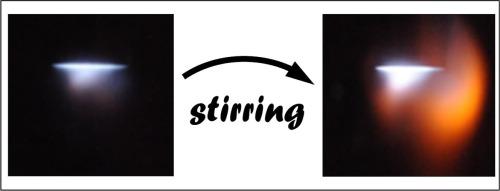Effect of mechanical stirring on sonoluminescence and sonochemiluminescence
IF 8.7
1区 化学
Q1 ACOUSTICS
引用次数: 0
Abstract
Light emissions from cavitating liquids serve as a diagnostic tool for chemical activity, bubble collapse conditions, or excited species. Here we demonstrate the influence of mechanical stirring on sonoluminescence (SL) and sonochemiluminescence (SCL) emissions emerging in the presence of dissolved sodium salts and luminol in different sonicated liquids. In the systems investigated, driven in the 20–40 kHz range, stirring can change the spatial distribution of blue/white broadband SL emissions and of the orange sodium D-line emission, as well as their relative intensities. In many cases, an amplification of sodium emission is observed under stirring, but striking exceptions appear as well. SCL emission from luminol is mainly quenched by the mechanical agitation. The liquids under study comprise water, ethylene glycol, and phosphoric acid, all with dissolved argon or krypton, and partly xenon. From the stirring-induced changes in sonoluminescence and from high-speed video recordings, we try to draw conclusions on the actual effects of the induced rapid bulk liquid flow on the cavitating systems. Main effects seem to be enhanced gas diffusion and bubble separation or de-clustering, possibly by a separative impact of the stirring flow on populations of smaller and larger bubbles, respectively. As a consequence, large bubbles with extremely bright sonoluminescence flashes appear in phosphoric acid under stirring. Overall, a certain sensitivity of stirring effects on further system parameters has to be stated.

机械搅拌对超声发光和声化学发光的影响
空化液体发出的光可作为化学活性、气泡坍塌条件或激发物种的诊断工具。在这里,我们展示了机械搅拌对不同超声液体中溶解的钠盐和鲁米诺存在时产生的声发射(SL)和声化学发光(SCL)的影响。在所研究的系统中,在 20-40 kHz 的频率范围内,搅拌可以改变蓝色/白色宽带 SL 发射和橙色钠 D 线发射的空间分布,以及它们的相对强度。在许多情况下,搅拌会放大钠发射,但也有明显的例外。鲁米诺的 SCL 发射主要被机械搅拌淬灭。所研究的液体包括水、乙二醇和磷酸,所有这些液体中都溶解有氩气或氪气,还有部分氙气。从搅拌引起的声致发光变化和高速视频记录中,我们试图得出结论,说明诱导的大量液体快速流动对空化系统的实际影响。主要的影响似乎是气体扩散增强和气泡分离或去簇,这可能是由于搅拌流分别对较小和较大的气泡群产生了分离影响。因此,在搅拌条件下,磷酸中会出现闪烁着极亮声波荧光的大气泡。总之,必须指出搅拌效应对其他系统参数的某种敏感性。
本文章由计算机程序翻译,如有差异,请以英文原文为准。
求助全文
约1分钟内获得全文
求助全文
来源期刊

Ultrasonics Sonochemistry
化学-化学综合
CiteScore
15.80
自引率
11.90%
发文量
361
审稿时长
59 days
期刊介绍:
Ultrasonics Sonochemistry stands as a premier international journal dedicated to the publication of high-quality research articles primarily focusing on chemical reactions and reactors induced by ultrasonic waves, known as sonochemistry. Beyond chemical reactions, the journal also welcomes contributions related to cavitation-induced events and processing, including sonoluminescence, and the transformation of materials on chemical, physical, and biological levels.
Since its inception in 1994, Ultrasonics Sonochemistry has consistently maintained a top ranking in the "Acoustics" category, reflecting its esteemed reputation in the field. The journal publishes exceptional papers covering various areas of ultrasonics and sonochemistry. Its contributions are highly regarded by both academia and industry stakeholders, demonstrating its relevance and impact in advancing research and innovation.
 求助内容:
求助内容: 应助结果提醒方式:
应助结果提醒方式:


